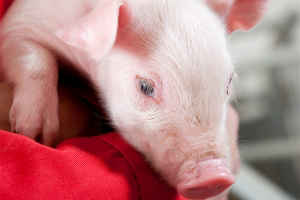BLOG: The piglet gut profits infant nutrition

Next to rats and mice, piglets have become one of the most frequently used animal models to study human neonatal nutrition. The piglet is often the model of choice because of its metabolic similarity to humans, particularly the growing infant and child. But how can animal nutritionist benefit from it as well?
Although the studies, in which piglets are used as a model, are often aimed to build a comprehensive set of data for developing new infant food products or to understand why young children suffer from non-infectious diarrhea for example, the results gained in these trials offer valuable information for animal nutritionists. Numerous studies can be found that delve into the effects of certain ingredients on the gut flora, digestive health and health status in general, providing useful information for animal nutritionist that look for ways to lower antibiotic use via alternative ingredients or to prevent diarrhea in weaned pigs.
Food companies jump on lactoferrin
Take lactoferrin for example, an antimicrobial and immunomodulatory protein that is produced in milk and aids in the gastrointestinal (GI) maturation of infants. Beneficial health effects have been observed when supplementing human and animal diets with (bovine) lactoferrin and many studies have been done in the last 10-15 years. However, the ingredient was only granted approval for use in human food as of December 2012 when the EFSA approved bovine lactoferrin as novel food after an application from Dutch company FrieslandCampina. Since then, food companies are very interested in using this lactoferrin in infant formulas. Nestlé for example has put forward its patent in 2013 claiming lactoferrin can reduce diarrhoea in infants. The patent application is based on piglet trials that showed that lactoferrin not only decreased the incidence and severity of diarrhoea, but also delayed the onset of diarrhoea. Via extrapolation, Nestlé said the piglet models were applicable to “in particular non-infectious weaning diarrhoea of infants or children”.
Post-weaning diarrhoea and gut bacteria
As all these studies are aimed at increasing gut health and thus preventing diarrhoea, I think there is huge potential for the pig industry, considering that post-weaning diarrhoea (PWD) is the major cause of economic loss in pig production. You can’t rely solely on the sow’s milk, as it contains only 0-6 mg lactoferrin per millilitre. Results from Chinese work in 2006 showed an improved growth performance, increased ADG by 41.80% and increased efficiency of gain by 17.20% when the pigs were supplemented with lactoferrin. They concluded that the use of lactoferrin as an additive to improve nonspecific immunity and strengthen host defences would be good a method of defending weaned pigs from infections and weanling stress. But is there also an effect on the bacteria in the gut? In 2012, researchers from the United States Department of Agriculture looked at the effect of lactoferrin on shedding of Salmonella Typhimurium in pigs. After five days the researchers did not notice any difference between the control and lactoferrin-supplemented group on the amount of Salmonella in the faeces. They therefore recommend more research on the duration of feeding and/or the levels of lactoferrin fed in conjunction with a more subtle Salmonella challenge. Finnish researchers sadly came to the same conclusion when they studied the effect of bovine lactoferrin on experimental Escherichia coli (E. coli) diarrhoea in weaned pigs. Lactoferrin was given seven days before and eight days after the challenge with E. coli. Lactoferrin administration to the pigs, in different dosage levels, had no statistically significant effect on occurrence of diarrhoea, haemolytic E. coli count in the faeces, weight gain, or haemoglobin concentration in treated groups compared with the control groups. They also recommend further research to show the antibacterial effect of lactoferrin in vivo.
Stay piglets in their modest role?
Although many studies can be found on the positive effect of lactoferrin in both infants and young children as piglets, I am wondering how often lactoferrin is actually supplemented in the diet of pigs. Or is it only done at experimental level?
Researchers agree that lactoferrin may be regarded as a potential in-feed additive for weaning pig diets, that is a fact. But is it maybe too expensive? And can you speak about a payback time when post-weaning diarrhoea is reduced? I know that the world of infant formulas is million dollar making business, so frankly speaking, I think the piglets will stay in their modest role as ‘model for the human gut’…for now at least….











